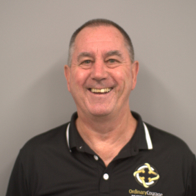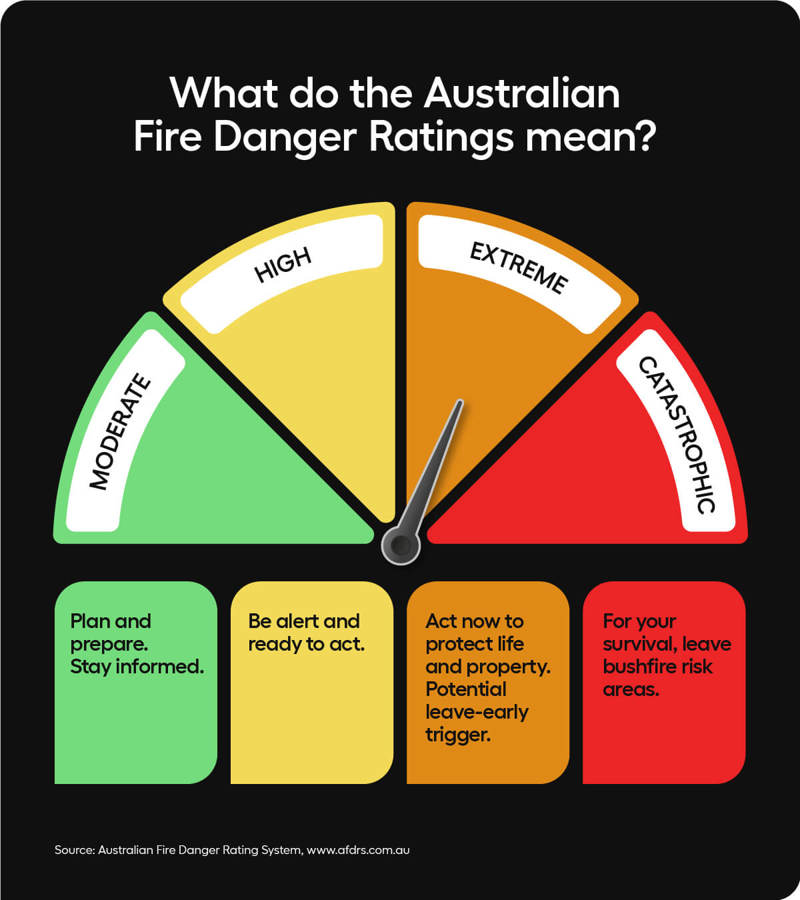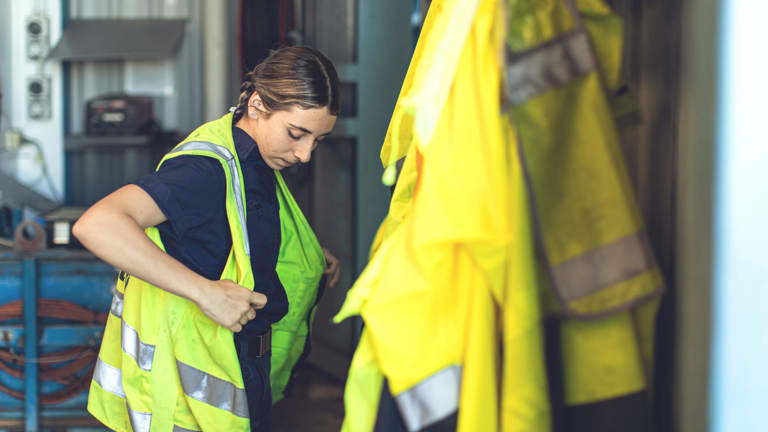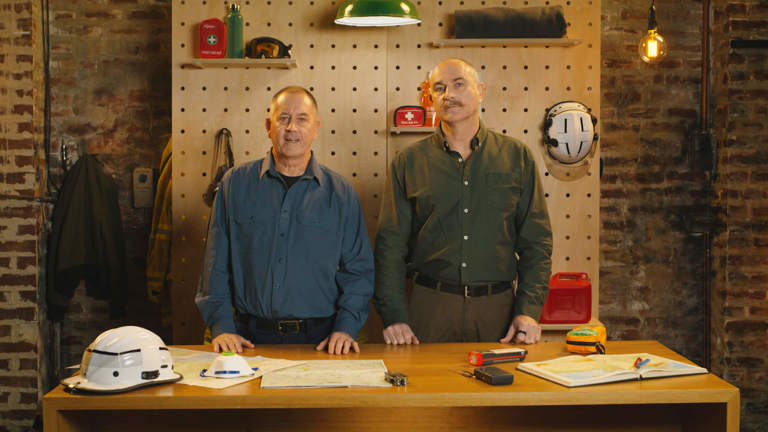Leave early or stay and defend? You might be familiar with the conventional advice that asks households to choose between these two options in case of a bushfire. But did you know that approach has now changed?
“With bushfires a more intense, more frequent reality in Australia, fire services rarely recommend staying and defending your property now if you’re in the direct path of a bushfire,” says Jim Smith, volunteer firefighter and former Deputy Commissioner of Fire and Rescue NSW.
“The latest advice holds that leaving early with a well-prepared property and a well-thought-out leave trigger is always your safest option and should be the primary goal of your bushfire safety strategy.”
Mark Dobson, long-serving firefighter and volunteer team manager at Disaster Relief Australia, adds, “You need to have your bushfire survival plan in place well before fires develop in your area. That means having essential items in your bushfire emergency kit already packed and ready to go so that when your agreed trigger occurs, you can just leave.”
Australia’s new bushfire profile: What’s changed?
“The biggest change to bushfire behaviour over the past two decades has been the scale and speed with which fires move and their intensity, and this has to do with temperature, humidity and fuel loads,” explains Mark.
“Our bush has become denser and dryer, and this, combined with lower humidity and high temperature, means more fires start, and they burn more furiously.”
Jim adds, “Our bushfire seasons are also becoming increasingly unpredictable. We have many more fires burning at once, with the likelihood that they will merge and become mega-fires.
“That makes staying and defending against a fire too dangerous for most of us now, so it’s more important than ever for every Australian to know when to leave for safety.”
When should you leave a bushfire zone?
“The best time to leave your property is the day before a bushfire front arrives, especially if you have vulnerable people in your family, such as children, the elderly, or asthmatics,” advises Jim.
Departing early can mean evading panic, becoming trapped, making the wrong choices or risking serious injury or death.1
“Do your final preparations the day before you depart and leave early the next morning or the night before.”

"The worst thing you can do when a fire is approaching is to try to leave your home,” he says.
If a fire front is outside your doorstep or has already reached your escape roads, it is probably too late to leave.
“Being caught in the open in your car is when many people die because they have no real shelter at all.”
Making a bushfire survival plan
Your first and best defence against bushfires, a bushfire survival plan is an agreed-upon course of action that covers what to do, when to act and where to go in the event of a bushfire. Jim advises discussing your plan with the whole family or household and reviewing it annually.
Jim says a bushfire survival plan will generally include the following information:
- Who needs protection: family or household members (such as young children and the elderly), neighbours, pets, livestock and visitors.
- When to leave, and what will trigger the decision to leave.
- What to do if circumstances change and you’re unable to leave before a fire arrives.
- Where to find shelter, and how to get there.
- Who to notify.
- What items to include in your bushfire emergency kit.
What is a leave early trigger?
A leave early trigger is an event identified in your bushfire survival plan as the moment you will evacuate to a safer place. Triggers may vary from household to household, depending on your location and circumstances. Jim suggests considering the following triggers:
- Leave when there’s a fire moving towards you, as long as it’s not yet reached your escape roads.
- Leave when an Emergency Alert is issued for your area.2
- Leave when a fire danger rating of Extreme or Catastrophic is forecast for the next day.3
“Many people only have a vague bushfire plan in their head and follow the ‘wait and see’ philosophy. This can often be a recipe for disaster,” explains Jim.
“But if you’ve identified a good trigger to leave that suits your family, then you can be in a safe place well before the fire front arrives.”
Understanding the Australian Fire Danger Rating System
As of September 2022, Australia simplified its Fire Danger Rating System. This aims to make it easier for you to make decisions on days when there’s a fire danger risk.3
“Fire danger ratings are a key tool to help you decide what to do to manage your own bushfire safety and should be a leading factor in your decision to leave,” says Mark.
Here’s a breakdown of the updated Australian Fire Danger Ratings and the level of threat each indicates:

Moderate
Plan and prepare. Most fires can be controlled, but stay informed and be ready to act.3
High
Be ready to act. There’s a heightened risk of dangerous fires. Be alert for nearby fires and know what you’ll do if one starts.3
Extreme
Act now to protect your life and property. These are dangerous fire conditions, and fires will spread quickly. If you and your property are not prepared to the highest level, go to a safer location well before the fire impacts. Reconsider travel through bushfire risk areas.3
Catastrophic
For your survival, leave bushfire risk areas. These are the most dangerous conditions for a fire. Go to a safer location early in the morning or the night before. Your life may depend on the decisions you make, even before there is a fire.3
“I was part of the Australian committee that decided on changing the highest rating from Extreme to Catastrophic,” Jim says, “and we did that to drill home the message. People don’t always pay attention to ‘Extreme’, but they’ll leave if you say ‘Catastrophic’.”
Preparing your property to leave
It’s important to give firefighters the best chance of protecting your property in your absence. Jim advises you do the following tasks well in advance:
- Clear space between bushland and your property.
- Clear ground litter from your property and roof litter from your home.
- Block downpipes with a tennis ball or sock filled with sand and fill gutters with water (don’t forget to remove the blockage once the danger has passed).
- Cut the grass around your property to 10cm or less.
- Remove combustibles such as woodpiles, hanging baskets, outdoor furniture and mulch from around all buildings.
- Apply metal fly screen mesh over vent holes to stop embers getting under the house or into roofs.
- Wet down the sides of your property, including decks and plants.
- Take down curtains and move furniture away from windows.
- Make sure your house number is displayed at the road.
- Identify water sources for firefighters, such as hydrants, water tanks, pools or creeks.
- Check ingress and egress or access routes to your property for fire truck access (of at least four metres in width and height, with a turnaround area).
Make a contingency plan
Even the best-laid plans can fail. If you can’t leave early, it might be helpful to set out in your bushfire survival plan steps to either shelter in your home or at an identified safer place.
“This could be because a fire has started very close to you, your exit route has been cut off, or a fire has spread much quicker than anticipated,” says Jim.
Here are some essential tasks and safety tips Jim suggests you include on your shelter-at-home checklist:
- Shelter in the house on the side farthest away from the fire, in a room with multiple escape points.
- Fill the bath and buckets with water.
- Disconnect hoses and fittings and bring them inside so they don’t burn.
- Close windows and doors.
- Stay low and use woollen blankets to protect yourself from heat.
- Seal gaps under doors and windows with wet towels.
- Patrol and check for embers inside, particularly in the roof space.
- Drink plenty of water.
- If the conditions in the house become unbearable, move to a burned area (if possible) with blankets to shelter you from radiant heat.
What is a Neighbourhood Safer Place?
A Neighbourhood Safer Place is a local open space, such as a school or sports reserve, where people may gather as a last resort. These places may provide some protection from direct flame and heat from a fire but do not guarantee your safety.4
“Neighbourhood Safer Places may be a better option than your home if they have large cleared areas, good shelter, are easy to get to, and the fire is still far enough away to travel in the open.”

“Your bushfire survival plan should have identified this site and how to get there by several different routes if possible.”
To find your nearest Neighbourhood Safer Place, check with your council or on your local or state fire services website.
Staying informed
“Often, you won’t be told when to leave,” Jim explains. “If there is bushfire activity near your area, it’s up to you to monitor the situation by tuning into local media such as ABC radio, fire and emergency services websites, and to understand the Australian Fire Danger Ratings.”
For more expert tips to help you get bushfire ready, visit our you.prepared emergency content hub.
Jim Smith & Mark Dobson
With a combined firefighting history of more than 60 years, Jim Smith and Mark Dobson are leading members of Australia’s firefighting community. Their experience encompasses major bushfire events, including the Canberra Bushfires in 2003, Black Saturday in 2009 and the Black Summer fires of 2019-20. The pair now work together in their respective roles as General Manager and Founder of Ordinary Courage, a consultancy dedicated to providing organisations with the tools to sustain good workplace mental health. Youi is proud to partner with Jim and Mark in the creation of this bushfire preparedness content.
The content in this article has been prepared based on current government and emergency services guidelines and expert advice provided at the time of publishing. This information is subject to change. Please be sure to check for the latest information and always consider your personal circumstances regarding bushfire preparedness and response.
Where you have increased your cover or reduced your excess within 72 hours (or other period noted on your policy schedule) of a flood, storm, hail or bushfire occurring, cover will be limited to the amount that was effective prior to the change. Loss, damage or legal liability caused by, resulting or arising from flood, storm, hail or bushfire during the first 72 hours (or other period noted on your policy schedule) of your policy first being purchased is excluded unless certain conditions apply. Refer to the relevant PDS, TMD and your policy schedule for full T&Cs.
1 Source: Country Fire Authority – Your Bushfire Plan
2 Source: Emergency Alert – Do Not Block +61 444 444 444
3 Source: Australian Fire Danger Rating System – Know the Changes. They could save your life
4 Source: Fire Rescue Victoria – Neighbourhood Safer Places



